I am a sucker for most anything different when it comes to stuff I get interested in. Accordions are no exception, and there is plenty of fodder out there. While there are numerous piano oddballs, I'm a CBA player, and I prefer stuff that I might be able to play sometime. I have had several oddballs pass my way, and they have engendered a number of wonders as to "why?". I have two 1920's (?) vintage boxes that are what I would label as "combo" boxes. That is, they have a piano keyboard, (one of which the black keys are fakes, but the white keys are functional, some as enharmonics. The other has fully functional keys and buttons), combined with 2 or 3 rows of buttons in the CBA style. This post concerns the box with the fake black keys, pictured below.
Why? What was the thinking behind such a hybrid? While I haven't had the opportunity to inspect the mechanicals yet, I'm reasonably sure they are more complex than either design would be separately. So again, Why?
This box does not yield any clues as to the manufacturer, which I would very much like to know. As can be seen from the reed block pics, the reeds and valves are in excellent condition. The reed blocks carry a very faint rubber stamping which reads "Remanufactured by International Accordion Company ????". I've fooled around with it a little, but because of lack of use, the keys and buttons are somewhat stiff and don't always return fully. I'm hoping exercise will loosen them up to where it'll become playable. I'm thinking, because of the metal flake celluloid, that it is of American manufacture. Any ideas? [JimD?]
The other attraction to these accordions, for me, is the bling factor. The artistry involved (often handwork), is impressive. My second "Oddball" post is an excellent example of this. Internet opinions suggest the bling factor was a result of the vaudeville era and stage craft considerations. Any opinions here?
Thanks for the input,
Waldo
Why? What was the thinking behind such a hybrid? While I haven't had the opportunity to inspect the mechanicals yet, I'm reasonably sure they are more complex than either design would be separately. So again, Why?
This box does not yield any clues as to the manufacturer, which I would very much like to know. As can be seen from the reed block pics, the reeds and valves are in excellent condition. The reed blocks carry a very faint rubber stamping which reads "Remanufactured by International Accordion Company ????". I've fooled around with it a little, but because of lack of use, the keys and buttons are somewhat stiff and don't always return fully. I'm hoping exercise will loosen them up to where it'll become playable. I'm thinking, because of the metal flake celluloid, that it is of American manufacture. Any ideas? [JimD?]
The other attraction to these accordions, for me, is the bling factor. The artistry involved (often handwork), is impressive. My second "Oddball" post is an excellent example of this. Internet opinions suggest the bling factor was a result of the vaudeville era and stage craft considerations. Any opinions here?
Thanks for the input,
Waldo
Attachments
-
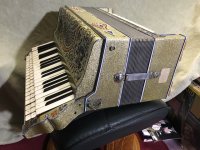 1B4E98F2-E907-4C7B-8A3B-0C53657E66FA.jpeg124.9 KB · Views: 6
1B4E98F2-E907-4C7B-8A3B-0C53657E66FA.jpeg124.9 KB · Views: 6 -
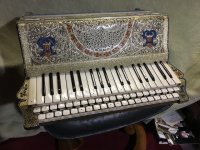 2A7186C3-2557-480B-A582-E037805B6A60.jpeg149.3 KB · Views: 6
2A7186C3-2557-480B-A582-E037805B6A60.jpeg149.3 KB · Views: 6 -
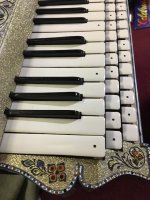 86F2F1B5-4581-47CE-94CD-4F2BA1BF0E02.jpeg106.2 KB · Views: 7
86F2F1B5-4581-47CE-94CD-4F2BA1BF0E02.jpeg106.2 KB · Views: 7 -
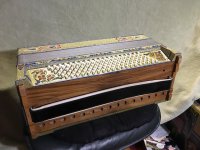 383F5B07-1E4D-4318-84B9-C72557092965.jpeg106.6 KB · Views: 8
383F5B07-1E4D-4318-84B9-C72557092965.jpeg106.6 KB · Views: 8 -
 0842AD05-F0F3-4A20-80AE-CB6AE4CDD971.jpeg116.9 KB · Views: 9
0842AD05-F0F3-4A20-80AE-CB6AE4CDD971.jpeg116.9 KB · Views: 9 -
 48050F24-FC0B-46C4-9204-D146C3B774A1.jpeg125.4 KB · Views: 7
48050F24-FC0B-46C4-9204-D146C3B774A1.jpeg125.4 KB · Views: 7 -
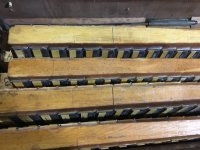 FFBD7A83-DFD6-4004-8DCF-E746A1AFDE9D.jpeg95.7 KB · Views: 5
FFBD7A83-DFD6-4004-8DCF-E746A1AFDE9D.jpeg95.7 KB · Views: 5

